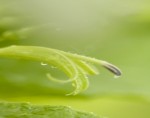Scientific Name: Delissea rhytidosperma
Also Known As: ‘Oha
Endemic: Kaua’i only
Description: This is a type of native lobelia (family Campanulaceae) with herbaceous stems that sometimes branch, it also has a rosette type arrangement of leaves that cluster toward the tips of the branches and curved tubular flowers. Each leaf is elliptical in shape, about 4-10 inches long and 2 inches wide with margins that are pointedly serrated. The flowers are whitish-green and about 11/2″ long and later fade to a dark maroon before falling off. The petals are small, pointed and narrow and the stamen is situated so that it perfectly dabs pollen on the head of native nectar feeding birds so that they can pollinate other flowers in return. This flower design is common among native lobelias that have co-evolved with native avifauna. Once pollinated, the flowers develop into small, fleshy fruit that are dark maroon, about ¾” round and are filled with many tiny seeds.
Distribution: This plant species belongs to an endemic genus of native lobelias known as Delissea. It is also an endangered species that is found only in remote mesic forests of Kaua’i, there are less than 20 plants known to be left in the wild.
Cultural Uses: There are no known cultural uses of this particular plant but it is known that other members of this family are used as bait to catch birds. Bird catchers would place sticky glue made from the fruit sap of papala kepau (Pisonia spp.) on the branch that the bird would perch on to feed, it would then become stuck to the branch making it easy to retrieve. The flowers of many other species of the family Campanulaceae are also used in making lei.
Landscape Use and Care: Delissea look great as specimen plants around larger landscaping stones or at the base of other larger trees or tall hapu’u ferns. Plant them in filtered sunlight and give them water about 3-4 times a week making sure not to over saturate them. Before you know it, you will be gazing at their interesting flowers and attractive fruit. Watch out for mites and mealy bugs that may occasionally distort the shape of the leaves and either make them spotty or crinkly or both. You can treat the problem manually by smooshing them with your fingers or spraying the underside of the leaves with water. You can also treat them by spraying pesticides. Right now this extremely rare plant is available at the Home Depots on O’ahu and Kaua’i for about $9.
Additional Info: Recently this plant has been divided into two separate species D. rhytidosperma and D. kauaiense based on morphological differences and population localities. These two along with D. subcordata of O’ahu (which may also be split as well soon) are believed to be the last three surviving species of ten species of Delissea that were once documented from Hawaii. Both Kaua’i species are listed as endangered and the O’ahu species is listed as threatened and all are on their way to share the same fate as the rest of the Delissea genus if more action is not taken to prevent this.
Delissea







